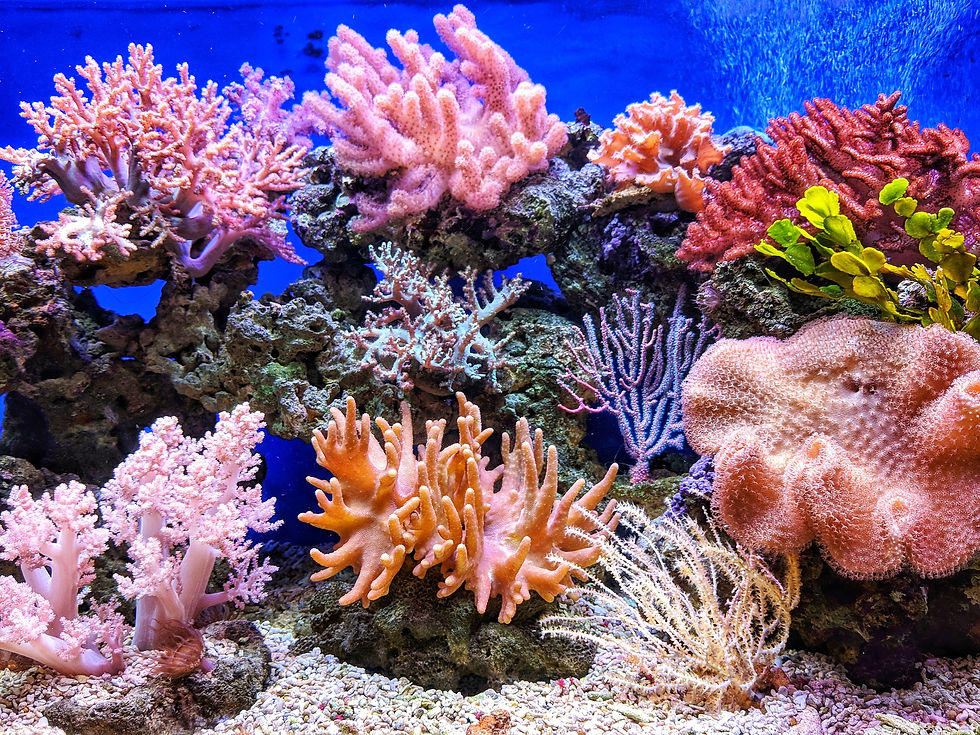Fashion in ‘The Plastic Age’
- Jennie Gilligan

- Jun 19, 2021
- 4 min read
Updated: Aug 16, 2021
As citizens of the 21st century, we are all living in ‘The Plastic Age’. Plastic pollution is such an evident issue that it is now in the fossil record. With eight million tonnes of plastic being dumped into the sea every year, this is not an issue that can be ignored.
Plastic pollution is killing and harming marine life and in turn, harming us as micro-plastics are in the air, ocean, and in the food chain.
How does fashion fit into this?
In order to keep up with new styles and trends, brands favour synthetic materials like polyester and nylon as they are readily available and affordable. There is an increased demand for plastic infused clothes from fast-fashion retailers as online shopping grows more popular, especially in the space of the Covid-19 pandemic. These type of clothes are affordable with a quick turn around for new styles to keep up with changing trends.
The Ellen MacArthur Foundation found that over half of the fast fashion produced is disposed of in under a year. The demand for cheap, almost ‘disposable’ clothes is high. But these garments are not disposable after all, they take decades to break down, and are polluting our oceans.
Who’s to blame?
With plastic pollution as an ever-growing problem, it is important for the consumer to shop more consciously. To shop consciously, we can boycott single use plastic and avoid fast-fashion – but this is easier said than done.
It is difficult for us to be conscious and sustainable as there is a lack of attainable alternatives. More often than not the blame and pressure to be sustainable is pushed onto the consumer rather than the industry itself.
While it is important to strive to be fashion conscious, tackling plastic pollution and unsustainable fashion requires experts from the fashion industry, the government, and specialists in the field to tackle this at its root.
Preventing plastic pollution is not a task that the consumer can control alone. The production, manufacturing, and fabrication of clothes that ignore the growing problem of plastic pollution in favour of cheap production and high sales is what needs tackling.
Can retailers be fashion conscious?
One way to tackle plastic pollution is to introduce laws that prevent brands and retailers from exploiting the use of plastic in fashion. The Fashion Pact, introduced in 2019 by Emmanuel Macron, aims to do just that. The Fashion Pact is ‘a global coalition of companies in the fashion and textile industry’. These brands include adidas, Gucci, the Aldo group, and many more.
This was introduced with the goals of ‘stopping global warming, restoring biodiversity, and protecting the oceans’. This is a fantastic step towards sustainability, representing well known, and trusted brands. While many high street, affordable brands are involved such as Mango, H&M Group, and adidas, the list is overwhelmingly filled with luxury brands such as Zimmerman, Chanel, and Hermes to name a few.
With little option for sustainability on the high street, the demand for affordable yet unsustainable fashion is still there.
Are brands being honest?
There is also an issue with the honesty and transparency of brands. The 2019 H&M Conscious collection was an example of this. This collection caused controversy for being ‘misleading’, not giving ‘precise information about why these clothes are labelled conscious’.
By labelling something with the positive term ‘conscious’, the consumer is manipulated into thinking they’re buying something sustainable. This is without actually being told what makes it ‘conscious’ or what that even means, creating fast fashion in disguise.
However, following this controversy, H&M labels their collection as having ‘at least 50% of each piece’ made from organic cotton or recycled polyester – a clear description so the consumer knows exactly what they’re spending their money on.
How brands can do their part while encouraging you to do the same
adidas have released a collaboration with Parley for the Oceans, a company to raise awareness of the destruction of our oceans. The adidas X Parley collection features high-performance sportswear, created from ‘up-cycled marine plastic waste that is intercepted from remote islands, beaches and coastal communities’. To see a trusted, recognised brand be fashion conscious in where they source their materials and how sustainable they can be is refreshing.
This collaboration runs alongside a social media campaign, aiming to educate people on plastic pollution and unsustainable shopping. This is a fantastic example of how the consumer and brand can work together to make a change and battle environmental issues, instead of leaving the customer at a loss of how to help.
What to take away
While the option to shop sustainably is becoming more readily available, these products tend to be less affordable. Online and high street retailers tend to favor profit over the environment. A great solution to fast fashion and changing trends is to up-cycle your clothes, refreshing vintage pieces to fit into your wardrobe and making them new again.
A tip I have always found useful is to shop less often from more sustainable sources, they may cost a little extra but will last and save you in the long run.
Be conscious with the items you do buy; can you see yourself wearing this year after year? Can you envision at least five outfits wearing this with items already in your wardrobe? If the answer is no, think about where your clothes will end up after your done with them and how this can be prevented.
Shopping sustainably with fashion conscious brands is the way forward in saving our oceans!



Comments